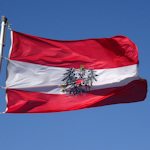
In 1918, Austria-Hungary effectively disintegrated after finding itself on the losing side of World War I. So what came next?
- WWI allies forced the Habsburgs from power
- The empire dissolved and “Austria” remained
- Now a democratic republic
- Book a tour* in the Habsburg capital
- See also:
- Previous: Austria-Hungary
- Next: More Habsburg terms
The end of an era
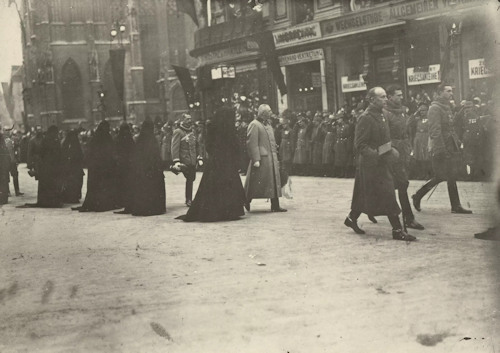
(Emperor Karl and Empress Zita at the funeral of Emperor Franz Josef in 1916; photographed by Franz Prohaska; Wien Museum Inv.-Nr. 67938; excerpt reproduced with permission under the terms of the CC0 licence)
As the echoes of battle died away, Austria-Hungary found itself with no money, no effective army, growing republican sentiments in Vienna, and a host of Czechs, Slovaks and others demanding their independence.
The victors of WWI also made it clear that an armistice depended on the formal end to both the empire and the monarchy. Many lands (including Hungary itself) quietly declared independence anyway since nobody was in any position to stop them from doing so.
The days of Habsburg rule were finished. Done and dusted. Game over.
The last emperor (Karl I, who came to power after Emperor Franz Joseph’s death in 1916) relinquished rule without ever formally abdicating, but was never able to return to power. He passed away in Madeira in 1922.
German Austria
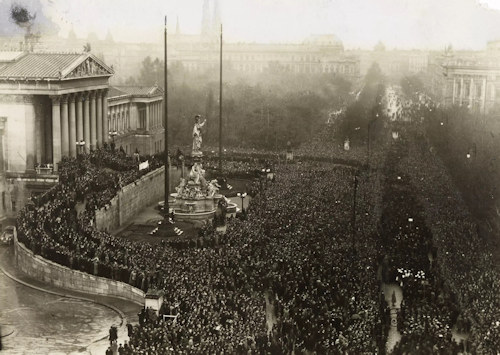
(Proclamation of the German Austria Republic on November 12th, 1918 outside parliament; photographed by Richard Hauffe; Wien Museum Inv.-Nr. 49342/13, excerpt reproduced with permission under the terms of the CC0 licence)
As everything collapsed around them, the German-speaking parts of Austria-Hungary declared themselves a democratic republic called German Austria. The “Provisional National Assembly of the Independent German-Austrian State” met in Vienna’s Palais Niederösterreich.
The goal was to eventually join Germany, since none of those German-speaking former Habsburg lands thought they could make it on their own.
The plan seemed like a reasonable one, except other countries had little enthusiasm for the idea of German Austria. And the baby republic had no international influence or military clout to gather any kind of support.
The treaty eventually signed with WWI’s victors in 1919 saw bits of would-be German Austria handed over to Italy, Yugoslavia, and Czechoslovakia. What was left did indeed remain a new republic, but only after agreeing to:
- Drop the German part from its name
- Give up any claims to join a greater Germany
And so German Austria never got off the ground.
When the dust settled at the end of 1919, Vienna found itself in the east of a small central European country called the Republic of Austria (more or less today’s country).
Given the city’s former imperial role, Vienna also ended up with an unusually large number of people and a broad mix of cultures. A legacy that continues today. For example:
- The city’s population passed the 2 million threshold in 2023/2024, and it continues to be around six to seven times the size of the next largest Austrian city (Graz in the province of Styria)
- Viennese surnames still hark back to times when numerous people moved there from Bohemia and other parts of the empire
What is Austria?
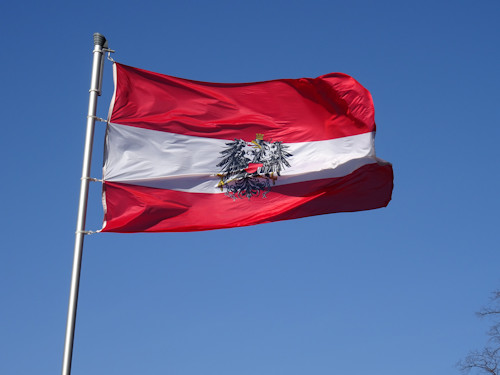
(The current flag of Austria)
One meaning of Austria, then, is the modern one: the country established after the end of WWI and whose geography and political system has remained largely intact since.
I say “largely,” because, for example, today’s Austrian province of Burgenland only joined from Hungary in 1921.
And, of course, Austria went through a dreadful period of fascist rule in the 1930s and 1940s that included several years as part of Nazi Germany.
Another use for the term Austria, however, is as a short-form for the previous incarnations of the Habsburg lands (particularly the Austrian Empire version). In 1813, people might have talked about an alliance with Austria and meant the Austrian Empire.
People also referred to Austria to largely mean the traditional Habsburg hereditary lands or the western part of the empire (as opposed to, for example, Hungary).
And, just to add to the potential confusion, an actual Austria (German: Österreich) has existed for centuries. The first written mention of this “Austria” was as far back as 996…
The Duchy of Austria
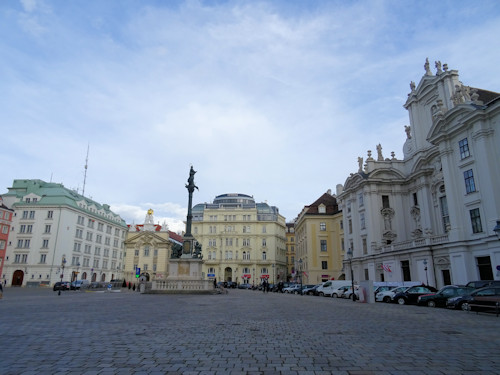
(Am Hof today, site of the 12th century residence of the first Duke of Austria)
The small Duchy of Austria was formally established in 1156 as a consolation prize for Duke Henry II for not getting Bavaria: the medieval equivalent of a swimming certificate or a packet of gummy bears for coming second.
With Vienna as its capital and the super location on the Danube, the duchy prospered and grew. It became an Archduchy in the 15th century.
This historical “Austria” expanded, shrunk, split, renamed and reformed repeatedly in the ebb and flow of politics, wars and split inheritances. If you want to retain your sanity, don’t even try to follow its progress through time.
It’s enough to know that a “real” Austria was also a geographical and political entity for many centuries. And this is why one of the many titles attached to the prevailing Habsburg emperor was Archduke of Austria.
Interestingly, today’s modern country of Austria never existed as a single entity at any point within the Habsburg era. It’s more or less the bits left over post-WWI after everyone else had claimed their territories or independence.
This inauspicious start makes Austria’s modern success quite astonishing: a cobbled-together nation rising from the ashes of two world wars to today’s prosperity, with Vienna regularly coming top of global quality of living rankings.
But Austria is not the last Habsburg-related concept that might cause you confusion. So let’s tidy up our understanding of history with a few more important Habsburg terms.